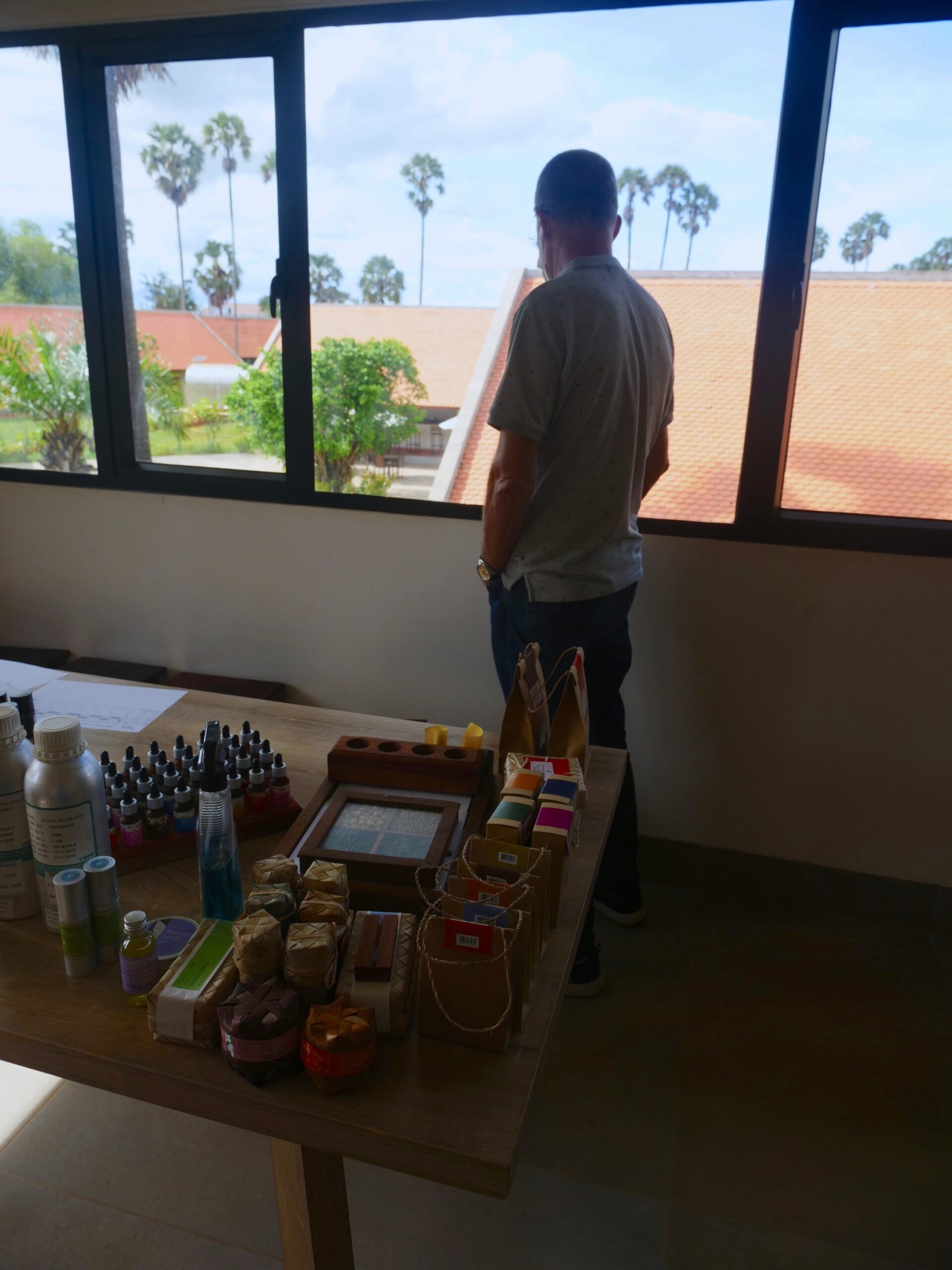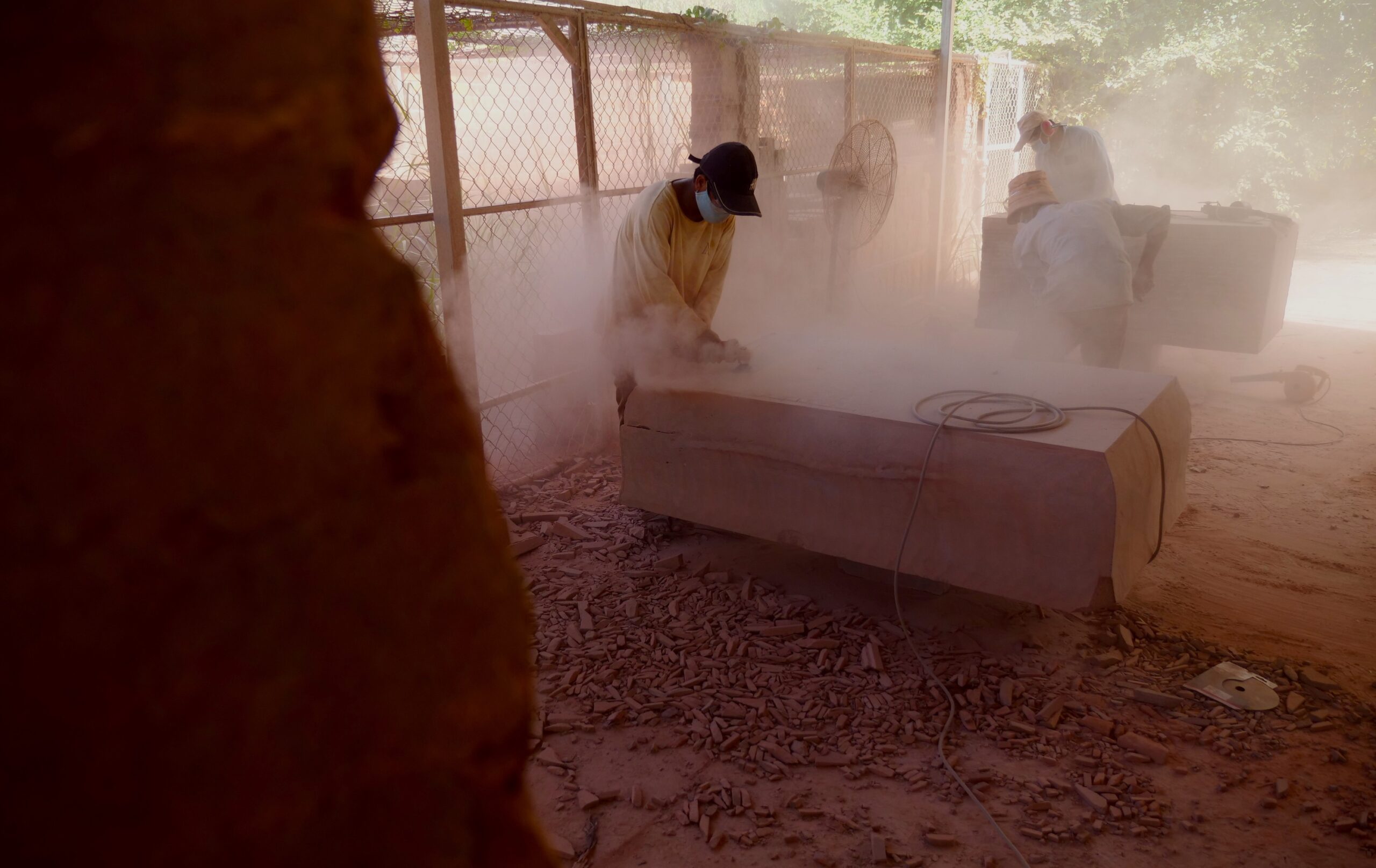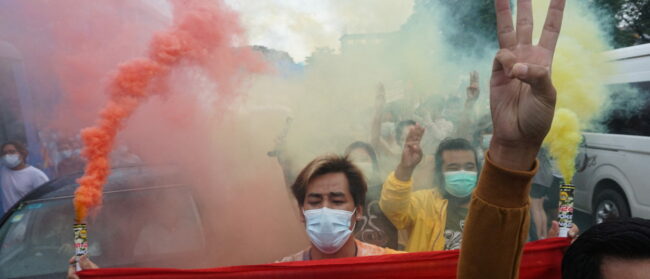On the outskirts of Siem Reap, the employees of natural cosmetics producer Senteurs d’Angkor unpackaged their products in late September, scooping out expired lip balm to salvage the containers for reuse. The lip balm would be thrown away.
“It is the opposite from before,” said Soem Sokhom, an employee of more than five years. “Before Covid-19, we only had a little product that expired, not like this.”
Cambodian companies have been devastated since the Covid-19 pandemic, especially in Siem Reap, where an average of 2 million visitors were once drawn to nearby Angkor Wat each year. Temple visitors have now slowed to a trickle, and across the Kingdom there have been a mere 108,000 international tourists in the first half of 2021.
Shuttered hotels and vacant restaurants are an ongoing reminder of the pandemic’s economic toll in Siem Reap, one of Cambodia’s poorest provinces. A less visible effect has been the gutting of the social enterprise business model and the handicraft industry, both of which have gone hand-in-hand with the province’s development as a major tourism hub since the 1990s.
Most of the staff will have been working for me for 10, 15 years, we cannot say okay, close the door, bye bye
Social enterprises provide a range of community services including employment, skills training, educational opportunities, social services and health care. Handicrafts companies producing and selling handmade textiles, sculptures and baskets often follow the model. Artisans Angkor and Senteurs have been major social enterprise employers within Siem Reap’s handicrafts economy, which included more than 6,400 people in the years leading up to the current collapse.
While Senteurs has never been solely profit-oriented, Covid-19 has increased the Siem Reap-based company’s financial burden as it has lost money every day since the pandemic’s onset, CEO Stephane Bourcier explained.
“We try our best to keep everyone on board,” said the 55 year old, who founded the company in 1999. “It’s my life project. Most of the staff will have been working for me for 10, 15 years, we cannot say okay, close the door, bye bye.”
In 2018, there were more than 40 handicraft companies in Cambodia, registered under the fair-trade Artisans Association of Cambodia. About a quarter of their membership is based in Siem Reap including Senteurs, according to executive director Sinoeun Men, who added that there are at least half a dozen more in Siem Reap that are not members.
Handicraft companies in the association collectively grossed between $2.5 million and $3.5 million annually prior to Covid-19, Men said.
“[Revenue] dropped a lot, dramatically,” he said. “To almost nothing. They don’t have a model.”

For surviving handicraft companies and social enterprises broadly, the challenge of balancing budgets, alongside obligations to employees and communities woven into their missions and brands, remains an ongoing dilemma.
The handicraft industry has not qualified for government employment aid to the ailing tourism sector, leaving companies like Senteurs to take employee welfare into their own hands.
“Many businesses have the dollars to support [employees] but lack motivation to do it,” Bourcier told the Globe. “Others lack dollars for their staff but have the motivation.”
In his office overlooking the Senteurs campus of water lilies and garden paths connecting tourists from the workshop to the gift shop, Bourcier keeps a cardboard box filled with dozens of small, palm-bark boxes – one for every kind Senteurs has ever produced.
“When we close, how can we start it again? To recreate all the activities, find the knowledge… I won’t have the energy,” he said. “If I close, I won’t open back.”
Bourcier worries about the future of the Krebei Riel boxes, one of the foundations of the Senteurs enterprise. To package incense, spices, scented candles and other wares, Bourcier partnered with women in nearby Krebei Riel village who mastered a unique form of basket-making crafted from thin, fire-hardened palm frond branches.
They turned their generational knowledge toward crafting boxes for Senteurs’ soaps, scents and perfumes, working together to grow the business from a small shop in Siem Reap’s old market to a sprawling campus where tourists could watch locals produce the cosmetics and crafts before buying.
“People who visit give life to this kind of craft,” Bourcier said of the Krebei Riel boxes. “If we stop, this knowledge will be done. I was the biggest company using this material.”
Senteurs previously ordered 1,000 boxes monthly from Krebei Riel villagers and 300,000 boxes of all kinds per year from nearby communities. These days, the orders from Krebei are down to 150 every two months.
With the onset of the pandemic, dozens of staff left to find better-paying work. There are now 100 staff who stayed on, many with a 50% pay cut. Senteurs’ salaries remain above the minimum wage for laid-off garment and manufacturing workers, who are eligible for a monthly $40 stipend under the government’s Covid-19 relief policy, with employers adding an additional $30 to meet minimum wage requirements.
A similar policy applies to the tourism sector in select provinces, including Siem Reap, but only covers guest houses, restaurants, hotels and tour operators. The handicraft industry, and social enterprise organizations more broadly, do not qualify.
“[The government] said no, we are not in the tourism sector,” Bourcier said. “For us, 95% of our income was coming from the tourists.”
Whereas the sectors receiving aid had well-established lobbying groups, social enterprise companies lack legal recognition. Under the law, they are considered either NGOs or profit-generating businesses. They subsequently have little representation in shaping government policy, explains Dara Huot, chief executive of the Phare Performing Social Enterprise who is helping develop a lobbying association for social enterprise organisations.
“The government says they support the tourism industry, but that is not the whole tourism industry. What about so many other people linked to the tourism industry? They don’t get that kind of support,” Huot said. “They should have included a lot more.”
I will just make things that I can sell to make money. I don’t have money
Even with a $95 salary from Senteurs, Suong Tong, one of the company’s longest-employed staff, said the amount is not enough to feed her children, pay for their education or her $200 loan repayments due to PRASAC Microfinance each month for the construction of her home. Like almost every other staff member, she receives rice, dried fish and other food from Senteurs every month.
The income from their work as intricate craft artisans used to be much more plentiful. To make a Krebei Riel box, Tong and her neighbors cut down palm branches from trees in their backyards before thinning and smoothing the wood. After drying and hardening strips under the sun, the women knit the wood into delicate shapes.

“All of Krebei Riel would benefit,” Tong said. “Because when thousands are ordered we asked our friends and neighbours to help.”
Tong now relies on other crafts to support her family. While her husband works in construction, the 39-year-old mother of three meticulously knits basket-bottoms wrought from the fibres of rattan palms. She spent five days preparing the materials and it will take another day to finish two basket bottoms, each netting 4,500 riel, or just over $1. It’s not much, but the last order Bourcier received at Senteurs was weeks ago.
“If Stephane doesn’t order the boxes, we don’t really make them,” she said. “I will just make things that I can sell to make money. I don’t have money.”
On the other side of the city, the downtown workshop of Artisans Angkor, once Siem Reap’s largest employer, lies empty. Of the 1,200 former employees, only a handful still arrive.
Designed as a vocational training initiative for rural Cambodians by the Ministry of Education in 1992, Artisans Angkor was later acquired by French firm VINCI Airports. The company runs all of Cambodia’s airports and dozens more across the world. Traffic at VINCI-owned airports was down 70% in 2020.
Artisans Angkor laid off nearly all of its workforce of more than 700 craftspeople in the early days of the pandemic. Workers received $30 monthly, down from an average salary of $180 to $450 per month pre-Covid. Even this small stop-gap payment was cut in February this year, though unlike other handicraft organizations, remaining Artisans Angkors employees still receive $40 in unemployment from the government, according to Tong Chhy, the company’s craft production coordinator.
“I don’t think it’s enough to support them,” Chhy said. “But we don’t have the funds to support them. They can try to survive by themselves or do something at home.”
At her home in Tachet village 30 minutes out from the city, former Artisans Angkor craftswoman Kimhan Loun has managed to earn some income through designing stone tiles for part-time, freelance gigs. It brings in enough to provide for the 36 year old’s family, as long as her husband keeps his construction job in far-away Kampong Cham province. She sees him only every few months.

“When I work for another company, I can’t get enough time to rest,” she said, noting the long lunch breaks and 5pm quitting time. “My wish is that Artisans can open again. I miss my colleagues.”
For the handful of sculptors still employed part-time by Artisans Angkor, chiselling the elephant-headed God Ganesha and a large wagon will require another month or two of work. They will receive around $300 each, though the final sale price or destination of the products is unknown to them.
“Trying to find a new job is difficult,” said 32-year-old Sun Sen, taking a break from chiselling a wheel. The men trained for six months at the craft, while many of their former colleagues now drive tuk tuks, farm in cassava fields or labor on construction projects.
Artisans Angkor previously teamed with Senteurs on a custom fragrance, which Senteurs sold in VINCI Airports. Bourcier then watched as Artisans Angkor closed their operations, along with dozens of private hotels and other large businesses.
“[Artisans Angkor] could have survived a bit longer if they wanted to,” Bourcier said. “I won’t have any regrets at least.”
The Krebei Riel craft workers employed by Senteurs mostly stay at home these days. The company also began raising chickens on its campus to help feed the staff and their families; not their intended product, Bourcier noted with exasperation.
Bourcier believes he can keep his full staff on payroll only for another few months.
“The ones who will lose the job first will be the ones who make the boxes, if I have to lay off people,” he said. “To stop [paying] them first is very tough.”
Additional reporting by Choulay Mech
This article was updated 4 October 2021 to clarify salary information for Senteurs employees and the number of orders received by the company.


